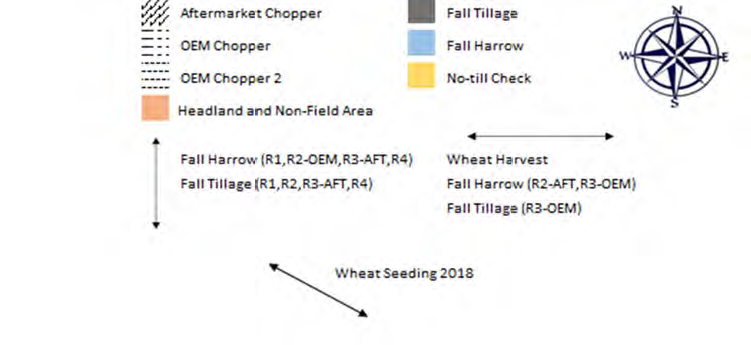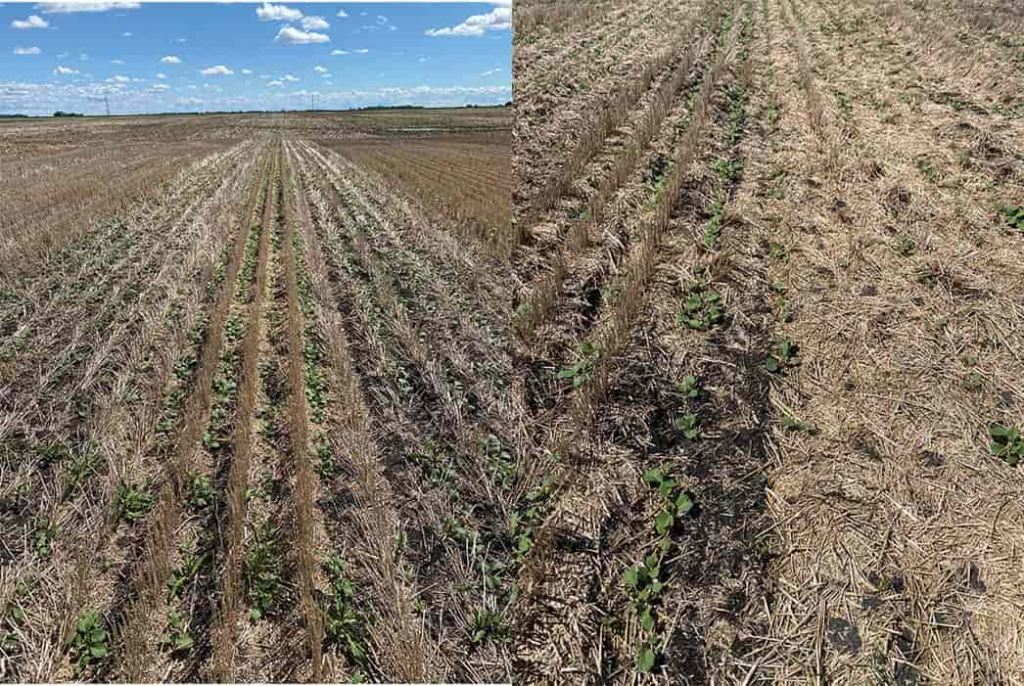Effect of Cereal Crop Residue Distribution on the Following Year's Canola Emergence and Yield


Figure 2. 2018/2019 treatment layout at Saint Front, Saskatchewan, Year 2.
OVERVIEW
Uneven and poorly distributed residue can lead to challenges, including uneven seed depth the following spring, blocked drill openers, and uneven plant stands and emergence. Because Western Canadian producers often rotate wheat and canola crops, the objective of this project was to analyze canola emergence and yield based on different wheat residue harvest management strategies.
Each site used a full quarter section of land to accommodate real-world equipment and management techniques. Researchers repeated the trieals at a different location each year to account for different soil properties, climatic variation and management. The Year 1 (2018) site was near the town of Delmas, Year 2 (2019) was near Saint Front, and Year 3 (2020) was near Nipawin.
Each site year started with a wheat harvest comparing two different combine choppers (representing “good” distribution vs “poor” distribution) as well as three post-harvest treatment areas (a check with no further management, a heavy-harrowed treatment, and a tilled treatment). All treatments were replicated. Sites were planted to canola the following spring, and measured for soil moisture, soil temperature, plant emergence counts, leaf staging, weed counts and end-of-season yield.
RESULTS
The after-market (AFT) choppers used throughout these trials provided a more even field finish than the poorly set original equipment manufacturer (OEM) choppers. The AFT choppers also provided smaller, fractioned residue than the OEM. The OEM chopper left the majority of the residue directly behind the chopper, which caused a strip pattern through the fields.
The post-harvest treatments aided in spreading the OEM residue clumps and provided minimal (visual) differences in the AFT treatments. The heavy-harrow treatment facilitated some clumps to be evened out, as well as some of the finer residue pieces to be incorporated into the soil. The tillage treatment incorporated more of the residue and provided a blackening effect on the soil surface.

However, when analyzing canola emergence across the three treatment years, researchers found few significant differences. The results varied by year between emergence inside and outside the chaff row. In Years 1 and 3, the emergence was higher outside the chaff row whereas in Year 2 the emergence was higher in the chaff row. This could be due to the very dry spring, resulting in moisture being the limiting factor, which was held in the residue and allowed for a better emergence. When comparing the emergence by chopper, there were few significant differences found that varied across year. Comparing the post-harvest treatments, the results varied each year with mostly the harrow or check treatment having the higher emergence count compared to the tillage. However, Year 3 did see a trend toward the harrow treatment experiencing the highest emergence across all treatments when comparing post-harvest treatments. This, however, was just a trend, and few significant differences were found in the data.
Although the results did not show many significant differences in canola emergence across treatments, some differences were noted. Proper residue management is recommended for a good plant stand, ease of in-field management, and a good canola harvest outcome.
Future work on this topic may consider analyzing results based on longer crop rotations and tillage treatments, as well as other factors that may be affected by the treatments (i.e., soil microbial community, disease pathogen levels, etc.). Results may have differed if trials were conducted on the same site over a number of years.
Link to external research sources by clicking the logo above.



